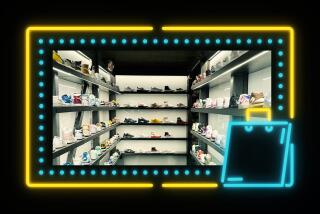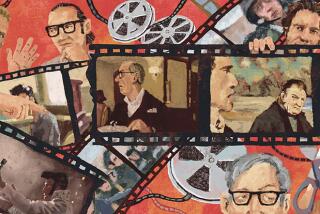‘Little Shop’s’ First Ending Gets Swallowed Up Again
- Share via
Audrey the Plant may be a Mean, Green Mother from Outer Space, but its conquest of Earth, seen in the original, unused ending of 1986’s “Little Shop of Horrors,” has gotten clipped a second time, weeks after the ending had its world premiere on DVD.
Warner Home Video’s special edition of the musical comedy gave viewers their first chance to see the movie’s legendary 23-minute finale, shot down by preview audiences, in which the plant devours hero Seymour Krelborn (Rick Moranis) and his beloved (Ellen Greene), then trashes New York in an epic spree of destruction.
But the DVD quickly became the format’s first collector’s item, when Warner recalled the title at the behest of the film’s producer, David Geffen.
So why was “Little Shop” shuttered? A Warner spokesman would only cite “artists’ relations,” but Geffen and the film’s director, Frank Oz (who gives an informative audio commentary on the DVD), have more to say.
Explains Oz: “David was upset, because the DVD used a black-and-white work print of the ending. He’s a caring producer--he put his guts into the movie--and after the DVD came out, he called me and said, ‘I have the color version. This could be better.’ ”
Geffen confirms that he was the force behind the recall, citing Warner’s use of a “black-and-white, unscored, third-generation copy of the ending.” He denies that he wished to suppress the downbeat finale; in fact, according to Oz, “David either wants to re-release the movie [with the original ending] in theaters, or at least have a better DVD.”
Geffen admits he’s considering both options, but won’t cite a timetable for his next step.
“Little Shop’s” costly quandary over a satisfying finale goes back to 1986--just after the filming of the off-Broadway hit, which was written by a pre-Disney Alan Menken and Howard Ashman.
*
Oz recalls the shoot itself as “happy and frustrating, the toughest I’ve ever done.” In that pre-computer graphics era, Audrey the plant was brought to life by Oz’s virtuoso staff of puppeteers, including Brian Henson, Jim’s son; to get Audrey’s lip movements as accurate as possible, the giant prop was shot at 16 frames per second instead of the usual 24. As a result, whenever Moranis or Greene performed in the same frame as Audrey, they had to move and speak slower than normal speed, to make their movements look natural in the final, sped-up film.
Fortunately, the end result seemed worth it. Menken and Ashman’s witty score, Oz’s stylish direction and a supporting cast that included Steve Martin and Bill Murray all promised a 1980s rarity: a movie musical smash . . . until San Jose.
“The first preview was glorious till the ending,” Oz recalls. “The audience was applauding after musical numbers. . . . [Warners chairmen] Bob Daly and Terry Semel were over the moon. . . . Then Rick and Ellen died, and the audience went stony cold silent. It was like a cemetery. They loved those characters, and they felt betrayed by us for killing them.”
Oz and lyricist-screenwriter Ashman were stunned. Oz asked the studio for another preview. The reaction from L.A. viewers was the same.
As a result, Oz reflects, “I learned my lesson. In the play, when the two main characters die, they come out for a curtain call. Movies don’t have curtain calls. Those characters are dead.
“Movies take you on a very personal journey. It gets down to the power of the tight shot; all your senses are on one image, the human face, and the camera brings out very subtle human emotions. The director and editor force you to look at an image, and that image isn’t an inch high, it’s 10-feet high.”
Learning that lesson didn’t make Oz’s next step any easier: He dropped the movie’s elaborate finale--in which a Godzilla-tall army of plants wrecks New York--and replaced it with an unsubtle happy ending.
“Howard and I didn’t want to do it,” Oz says, still sounding pained. “Howard and I felt very strongly that the plant should win. To David Geffen’s credit, he said before shooting, ‘You’re crazy, you cannot kill the two leads.’ But we wanted to stay true to the play.
“After the previews, if I hadn’t changed it, they would’ve hired another director. You don’t make a movie for three people, you make it for the audience, and they were telling us a different thing. I would’ve liked the ending a bit hipper and tongue-in-cheek, but the scores shot up because they lived.”
“Little Shop’s” happy coda didn’t quite echo off-screen. Box office was only fair--”People didn’t understand it was a funny musical,” Oz guesses--and the director still recalls the agony of telling model artist Richard Conway (“Brazil”) his re-creation of Manhattan had been entirely cut from the film.
“Conway was wonderful about it when I told him,” Oz recalls, “but it was just awful. A million dollars, six months of his life . . . and what he did was brilliant. I tried to make [the scenes] work in the recut--as a dream sequence, as end credits . . . but it just didn’t work, because Rick and Ellen had to ‘win.’ ”
Oz says he hopes 1990s audiences might be more accepting of “Little Shop’s” dark original vision. Perhaps one day he’ll find out; but for now, only a handful of DVD viewers can savor the flickering, black-and-white image of Moranis and Greene, unheroically devoured, before Ashman’s dirge-like lyrics warn, “Don’t Feed the Plants.”
To that message might be added a new second chorus: Don’t Forget to Call David Geffen First.
More to Read
The biggest entertainment stories
Get our big stories about Hollywood, film, television, music, arts, culture and more right in your inbox as soon as they publish.
You may occasionally receive promotional content from the Los Angeles Times.










